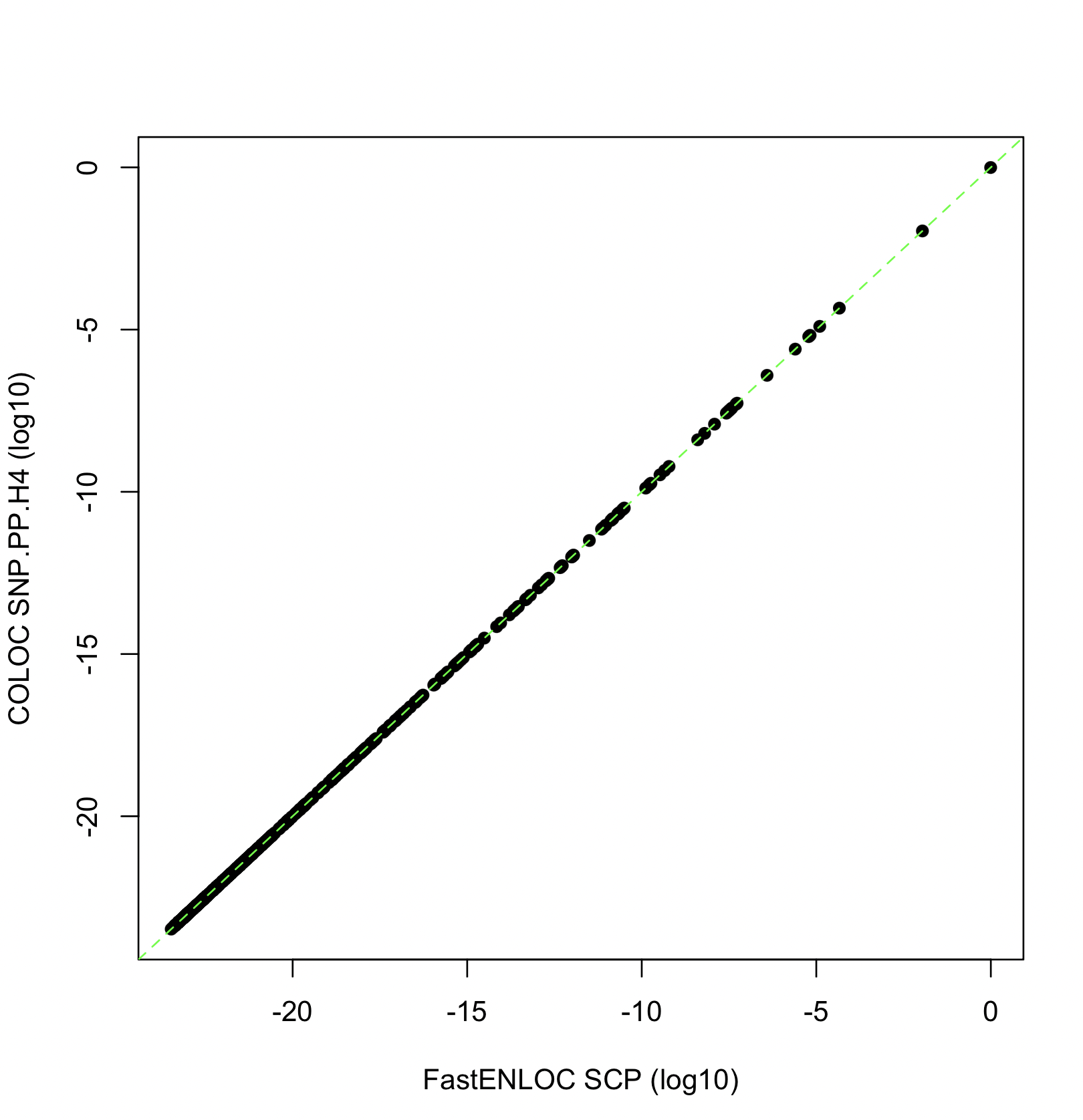
When summary statistics are used as input for colocalization analysis, both COLOC and FastENLOC require the same simplifying assumption that each trait has at most one causal variant per locus. Consequently, their algorithms for computing colocalization probabilities are nearly identical (see Wen et al. 2017 and Hukku et al. 2021 for details). However, differences in the specification of colocalization priors and hyper-parameter choices when computing Bayes factors (BFs) can lead the two methods to yield numerically different results in practice. Here, we present examples to illustrate and explain some of these discrepancies.
To demonstrate that COLOC and FastENLOC yield comparable results when using summary statistics input, we first analyze the coloc_test_data included in the coloc package. This dataset contains 500 SNPs from a single locus. We have reformatted it into a FastENLOC-compatible summary statistics input file, which can be downloaded here.
The procedure of running COLOC is described in here. The output from COLOC is as follows:
Coloc analysis of trait 1, trait 2
SNP Priors
p1 p2 p12
1e-04 1e-04 1e-05
Hypothesis Priors
H0 H1 H2 H3 H4
0.892505 0.05 0.05 0.002495 0.005
Posterior
nsnps H0 H1 H2 H3 H4
5.000000e+02 1.377000e-18 2.937336e-10 8.593226e-12 8.338917e-04 9.991661e-01
To align FastENLOC with COLOC’s settings on priors and hyperparameters, we use the following command to run FastENLOC:
fastenloc -sum coloc_test_data.sum --coloc_default_prior -sdy_e 1.099961 -sdy_g 1.021844 -prefix test_coloc
The on-screen output by FastENLOC is as follows:
==================================================================
FastENLOC (v3.1)
release date: November, 2024
==================================================================
Applying user-specified colocalization priors, skipping enrichment analysis
converting enrichment parameters:
Intercept -9.210
Enrichment 6.908
Processing combined summary statistics input ...
* read in 500 SNPs, 1 loci
Computing colocalization probabilities ...
[==================================================] 100%
FastENLOC analysis is completed
Note that --coloc_default_prior is equivalent to setting -p1 1e-4 -p2 1e-4 -p12 1e-5, which matches the default priors assumed by COLOC. The values for -sdy_e and -sdy_g are required to set hyperparameters for calculating Bayes factors. These can be computed from the datasets and provided to both COLOC and FastENLOC.
FastENLOC detects that colocalization priors are specified in the command line, so it skips enrichment analysis and converts the priors to the equivalent values of $\alpha_0 = -9.21$ and $\alpha_1 = 6.908$.
The locus-level FastENLOC results are saved in the file test_coloc.enloc.sig.out, which contains a single line in this example:
Signal Num_SNP CPIP_qtl CPIP_gwas_marginal CPIP_gwas_qtl_prior RCP LCP
Loc 500 1.000e+00 1.000e+00 1.000e+00 9.992e-01 1.000e+00
It is important to note that
\[\text{RCP} = \text{PPH4}\]and
\[\text{LCP} = \text{PPH4} + \text{PPH3}\]by their respective definitions. In this example, it is not surprising that the locus-level quantification of colocalization evidence is numerically identical between COLOC and FastENLOC, as we have carefully matched all parameters.
The SNP-level colocalization probabilities can be found in the file test_coloc.enloc.snp.out, as shown below:
Signal SNP PIP_qtl PIP_gwas_marginal PIP_gwas_qtl_prior SCP
Loc Loc:s103 2.633e-02 2.273e-01 1.138e-02 1.097e-02
Loc Loc:s105 9.558e-01 5.640e-01 9.882e-01 9.881e-01
To output all variants without thresholding, use the --output_all option on command line.
The output by COLOC also have these two SNPs with SNP.PP.H4 > 0.01:
snp position SNP.PP.H4
6 s103 0.01098066
8 s105 0.98894507
The figure below shows comparison between FastENLOC SCP values and COLOC SNP.PP.H4 values across all 500 SNPs in this dataset at the log10 scale.

When all other factors are equal, the two methods yield very similar results, as expected.
Next, we examine analytical factors that contribute to differences in the quantification of colocalization evidence when using the same input data and applying the simplifying fine-mapping assumption of at most one causal variant per locus.
To explore the factors contributing to differences between PPH4 and GRCP, we use a simulated dataset generated by Okamoto et al. 2023. This dataset includes 1,198 genes from chromosome 5, with each gene’s cis region containing 1,500 non-overlapping common SNPs. The gene expression levels and complex traits are simulated using real genotypes from 500 GTEx samples. We are using the summary statistic input file in this analysis.
To construct a starting point, we set all parameters between FastENLOC and COLOC the same values. These include:
With the wrapper R script run_coloc.R, one can run COLOC directly on the FastENLOC summary statistics input file as follows:
Rscript run_coloc.R okamoto_sim.sum_stats.gz
To run FastENLOC, use
fastenloc -sum okamoto_sim.sum_stats.gz -tv 1797000 --coloc_default_prior -sdy_e 1 -sdy_g 1
The figure below shows that the PPH4 values generated by COLOC and the GRCP values generated by FastENLOC for all 1,198 genes are nearly identical in this setting.
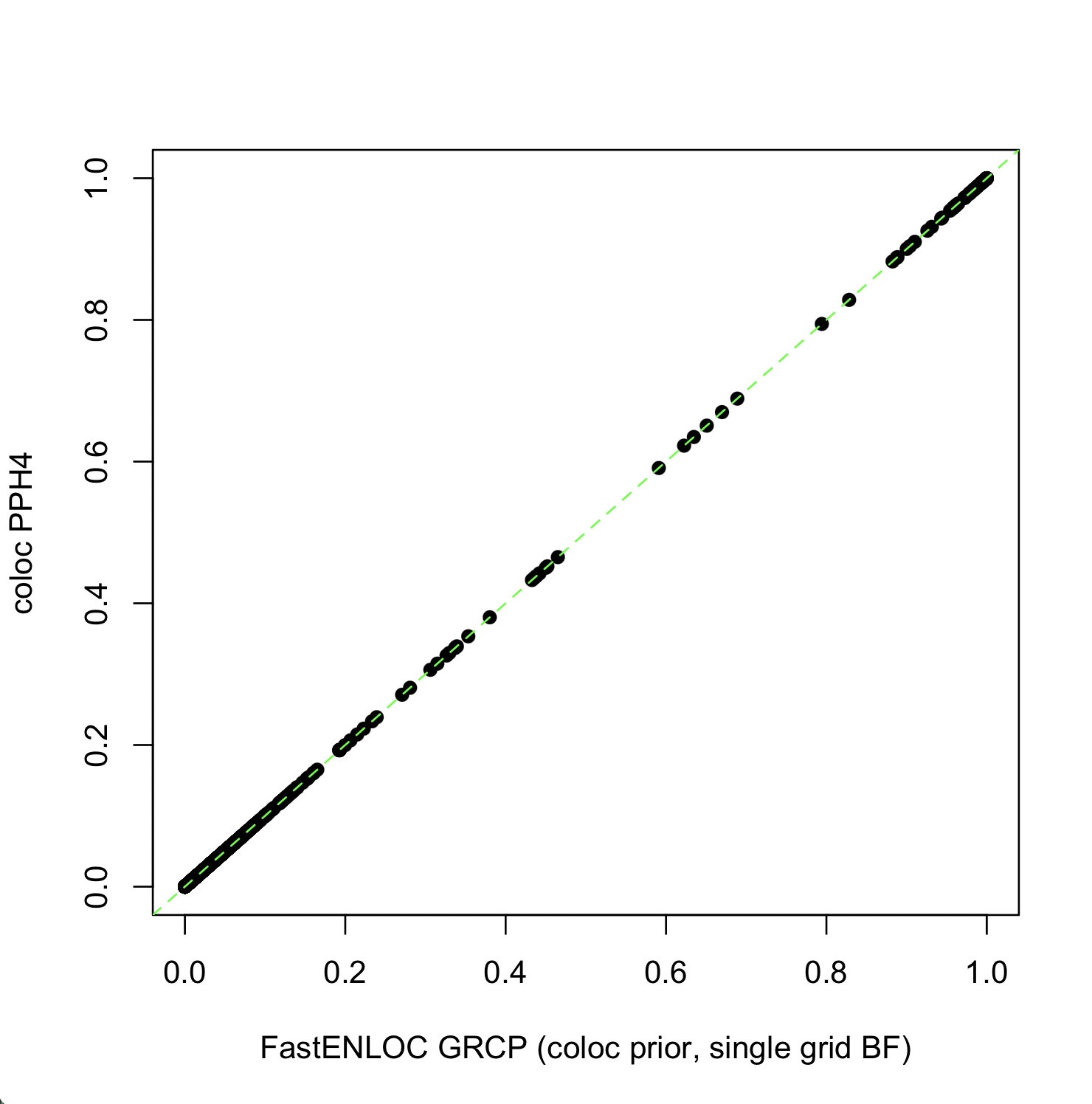
By default, FastENLOC computes the BFs across a range of prior effect sizes and averages the results to obtain a final value, a strategy advocated by Stephens and Balding, 2009. This is equivalent to assuming a mixture normal distribution on the prior genetic effect size In comparison, COLOC computes Bayes factor based on a single effect size prior determined by sdY. This subtle difference, which is not directly related to colocalization analysis, can lead to discrepancy in final colocalization probabilities.
The figure below show the GRCPs using averaged BF results versus COLOC’s PPH4 values using a single grid:
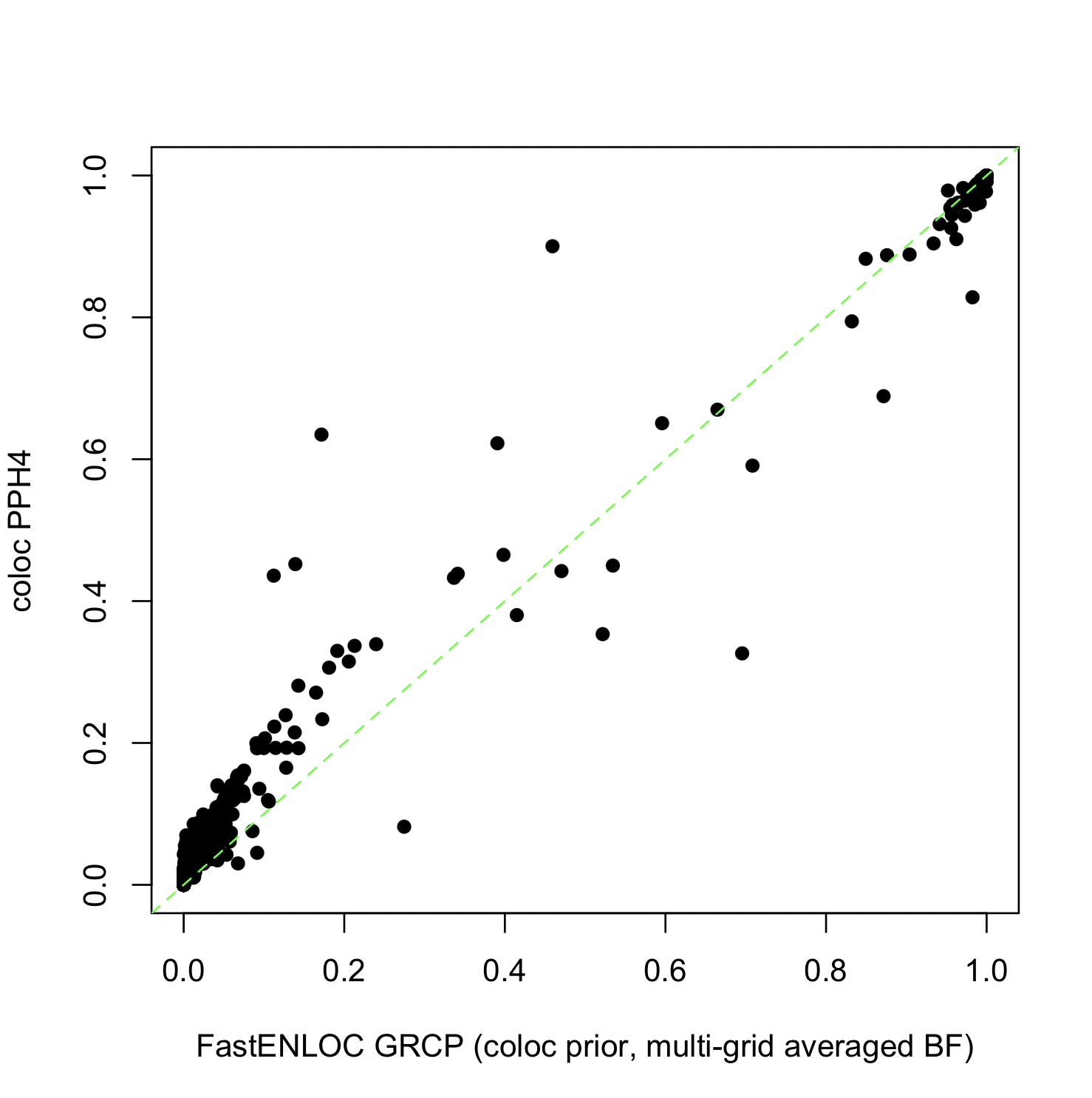
The FastENLOC results are obtained by
fastenloc -sum okamoto_sim.sum_stats.gz -tv 1797000 --coloc_default_prior
The results demonstrate that colocalization probabilities are sensitive to prior effect specifications. Generally, as argued by Stephens and Balding, 2009 and many others, averaged BFs are considered more robust.
FastENLOC can estimate colocalization priors directly from the data using a multiple imputation scheme, which is also applicable to summary statistics input. For the Okamoto data, the true enrichment parameters are $\alpha_0 = -7.31$ and $\alpha_1 = 5.81$. The estimates by FastENLOC are conservative, as expected:
Intercept -7.665 -
Enrichment (no shrinkage) 4.739 0.146
Enrichment (w/ shrinkage) 4.549 0.143
## Alternative (coloc) parameterization: p1 = 4.683e-04, p2 = 5.660e-04, p12 = 2.508e-05
The alternative parameterization, i.e., ($p_1, p_2, p_{12}$), shows that the estimated prior is reasonably close to the default prior assumed by COLOC. The impact on colocalization probabilities by the prior difference is shown below:
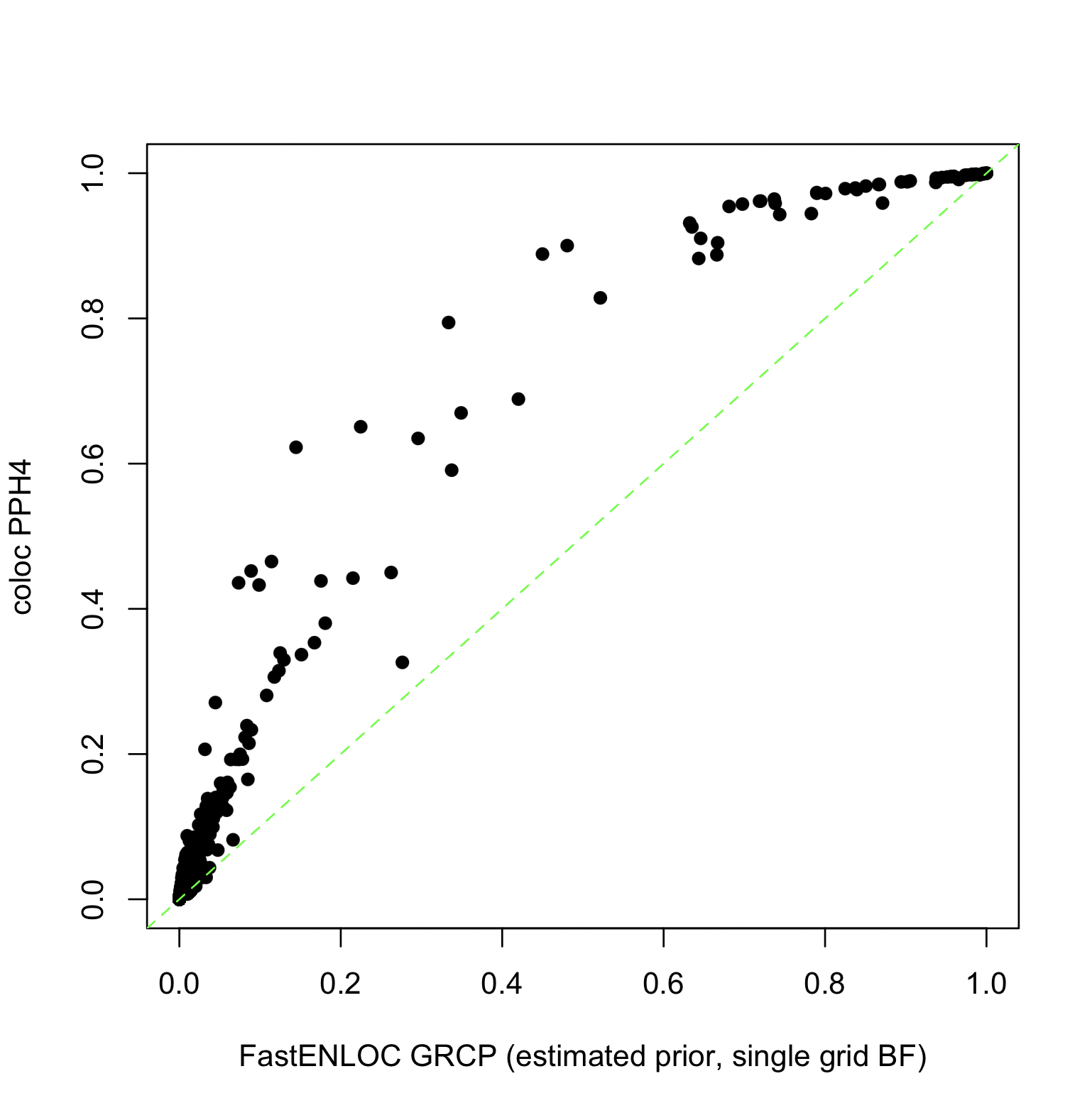
Here, we maintain consistent Bayes factor (BF) computations across both methods (assuming a single grid by defining sdY).
The command used to generate the above FastENLOC output is:
fastenloc -sum okamoto_sim.sum_stats.gz -tv 1797000 -sdy_g 1 -sdy_e 1
Since the corresponding $\alpha_1$ value (6.908) overestimates the true value, the PPH4 values are higher than the corresponding GRCP values.
When FastENLOC and COLOC use their respective default settings to compute colocalization probabilities, a higher level of discordance is observed between PPH4 and GRCP, as shown below.
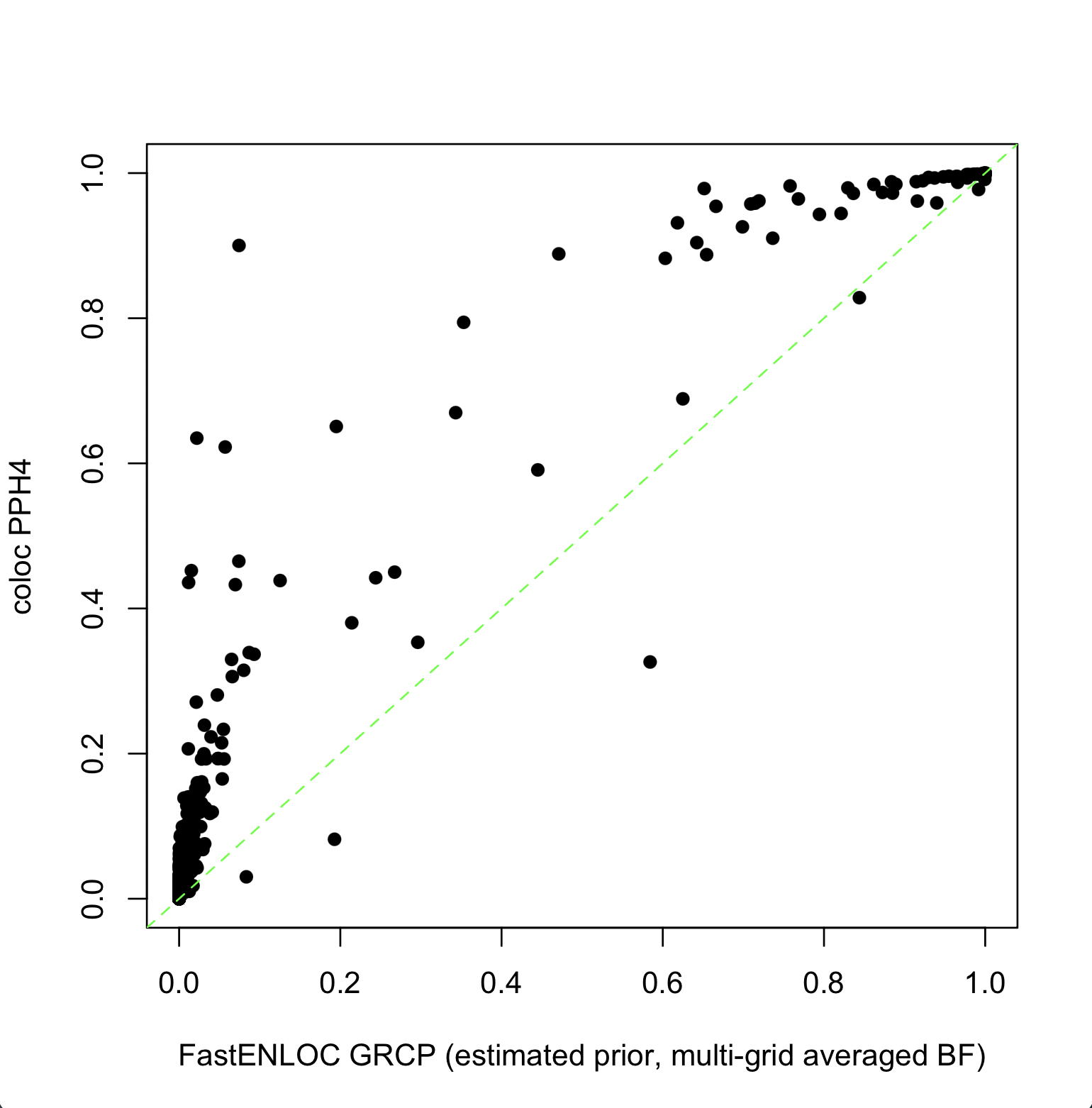
The command to generate the above FastENLOC output is:
fastenloc -sum okamoto_sim.sum_stats.gz -tv 1797000
While analytical factors can contribute to discrepancies in colocalization quantification between FastENLOC and COLOC, their results generally remain highly correlated. For instance, in the combined effect experiment, the GRCP and PPH4 results show a Spearman correlation of 0.905. We also identify a non-analytical cause of larger discrepancies between and within methods that perform colocalization analysis based on summary statistics input: the definition of gene (cis) regions.
The figure below shows the changes in PPH4 values computed by COLOC as the cis-region for each gene is halved in the Okamoto data.
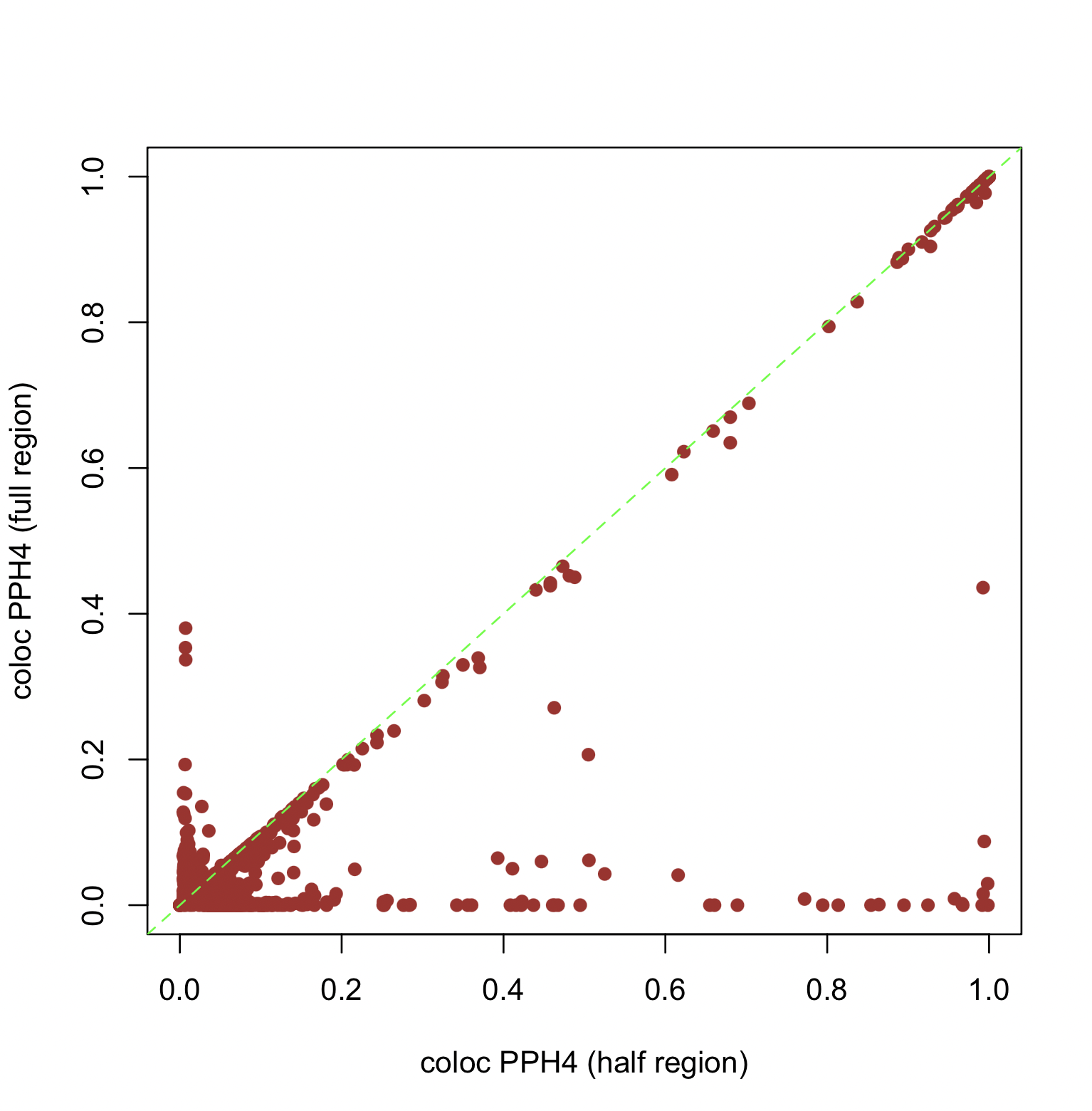
The change of the region definition also causes a drastic decrease in Spearman’s correlation to 0.161.
Sensitivity to region definition is a primary reason we recommend probabilistic fine-mapping input for colocalization analysis, as it is more robust to different region definitions.